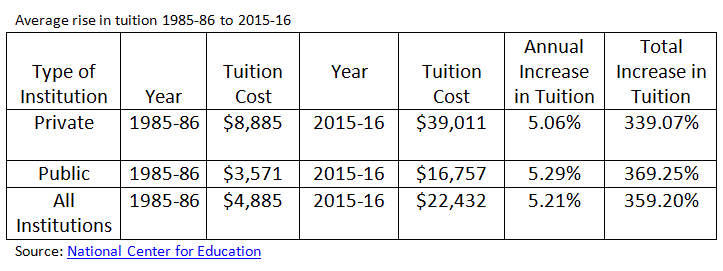
Why College Students Should Know the Cost of a College Education
With indications that current college students will need to accumulate well over one million dollars simply to remain in the middle class during their later years, pursuing financial freedom from an early age makes eminent sense. However, many teens or twenty-somethings tune out around talk about investing for retirement. Framing investment conversations that college students tune into can be as simple as avoiding the word “retirement”. You can also use more enticing verbiage like “financial freedom” or “not being broke” or “not having to work all of your life.”
Once you have their attention, help them understand how inflation will affect them over their lifetime. Ask them to consider the Grand Canyon and how it was slowly formed over millions of years. Similarly, inflation is virtually invisible and occurs one tiny uptick at a time: you don’t notice it on a daily basis, but over time the results are dramatic. For instance, with inflation running at an annual 3% clip, in 50 years the dollars people earn (and spend) will be worth less than a quarter of what they are worth today!
Young people relate to the rising cost of a college education so this can be something they can personally relate to. For instance, the chart below illustrates the rise in college tuition at a few top schools from 1985 to 2015.
Sources: University of Pennsylvania Archives and Records Center, Daily Trojan, University of Michigan Bulletin, Detroit News
While the cost increases for the above example took place over a 30-year period, the results are nevertheless staggering. Tuition costs at USC rose from $9,618 to $49,464, an overall increase of over 400%! This is in line with other private universities. According to the National Center for Education Statistics, the primary federal entity that tracks the cost of education, the average tuition at private colleges during the 1985-86 school year was $8,885. By the 2015-16 school year, the average cost of tuition rose to $39,011, a whopping 339% increase over the 30-year span! The numbers for public colleges reflect an even greater rise of 369% during this same 30-year period.
With the impact of inflation at top of mind, it’s a good time to also review the positive effects of compound interest and the potential benefits of a long-term, growth-oriented portfolio. For example, a potential 8% return in a hypothetical 3% inflation environment means an investor could have a ”real rate of return” of 5%. At a 5% annual real rate of return, their money, or purchasing power, will roughly double every 14 years. For example, if a 24 old is able to save $5,000 and earn an average real rate of return of 5%, that bucket of money at age 66 could be worth almost $39,000 in inflation-adjusted dollars. If they continue to save this $5,000 annually (not even counting potential higher savings associated with their higher future earnings), by age 66 they could have over $676,000!
Other than receiving a massive inheritance or winning the lottery, saving early and regularly is often the best tool a young person has to avoid Middle-Class Poverty later in life. Young people famously resist taking advice from their “elders,” particularly their parents. If this sounds like the young person in your life, try to speak in a language that gets their attention. Talk about how living expenses (like college expenses) can triple or quadruple in their lifetime. Then show them exciting examples of the power of compounding interest. Finding ways to reach them in terms they will “hear,” you can help them tackle the retirement planning challenge and they will be more likely to reach their own unique version of financial freedom.





A Must read the post before you go for an admission to a college or university, that’s a good writing and informative material in this post keep the good work mate!